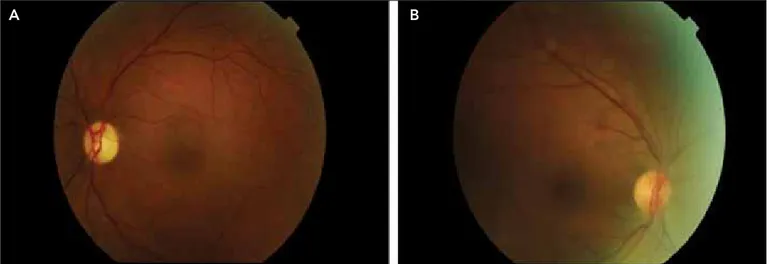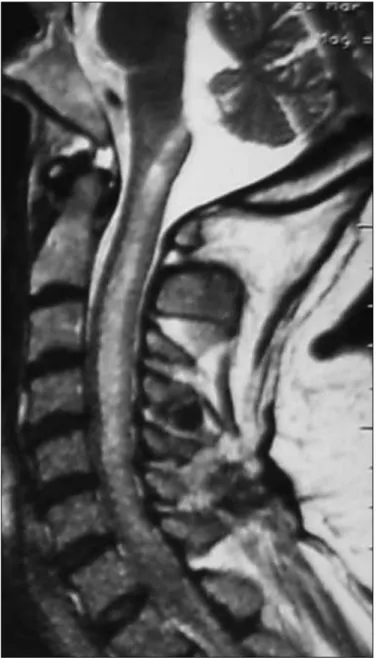99
A Case of Devic’s Syndrome Presenting with Tonic Spasm:
Response to Levetiracetam Treatment
1Department of Neurology, Faculty of Medicine, Ufuk University, Ankara, Turkey 2Department of Radiology, Faculty of Medicine, Ufuk University, Ankara, Turkey Alev Leventoğlu1, Demet Karadağ2, Zülküf Mehmet Önal1
Case Report
Introduction
The clinical features of Devic’s Syndrome (Neuromyelitis optica, Devic’s disease) include temporary blindness in one or both eyes, weakness or paralysis, painful spasms, and bladder and bowel problems. Clinical manifestations of this syndrome are caused by optic neuritis and tranverse myelitis. It may fol-low a monophasic or relapsing course. Tonic spasm (paroxys-mal dystonias, tonic seizures) is characterized by painful uni-lateral contractions of the upper or lower extremities (1, 2). Sometimes the attacks are stimulated by tactile stimulation or movement and are predated by transient sensory disturbance. Although most patients with Devic’s Syndrome have a normal cerebral MRI, inflammatory demyelinating lesions have been found in the spinal cord (3, 4), basal ganglia (5), midbrain, ce-rebral peduncle (6), internal capsule (7), and thalamus (8). Tonic spasms can be caused by lesions anywhere along the cortico-spinal pathways (9). Although tonic spasm is the most frequent movement disorder occuring in MS (10), it has not been a defi-nitely described clinical entity for Devic’s syndrome.
Devic’s syndrome is an inflammatory demyelinating cen-tral nervous system disease with involvement of the optic nerves and spinal cord. However, inflammation and damage to the myelin can occur anywhere in the brain. Devic’s syn-drome may follow a monophasic or relapsing course. The most frequent initial manifestation is acute transverse myeli-tis. Acute transverse myelitis is caused by inflammation of the spinal cord and severe neurological dysfunction worsening
over several hours to days. Furthermore, L’hermitte’s symp-tom, radicular pain and paroxysmal tonic spasms can devel-op, especially in patients with relapsing NMO.
Levetiracetam is a new antiepileptic drug used as adjunc-tive treatment for partial onset with or without secondary generalization in epilepsy. Even though the underlying mech-anism of action of levetiracetam has not been completely elu-cidated, the metabolism of GABA appears to be involved. Some reports indicate its effectiveness in the treatment of tardive dyskinesia, paroxysmal kinesigenic choreoathetosis and hemifacial spasm (11-14). To the best of our knowledge, this is an excellent drug for the treatment of patients with epilepsy and concomitant liver diseases (15).
We describe levetiracetam treatment for tonic spasms of a patient with Devic’s Syndrome. The patient responded rap-idly to the treatment.
Case Report
A 52-year old woman was admitted to our hospital with complaints of left leg pain, weakness, and dystonic posture. She said she had had right visual loss three months previously. She had a two weeks history of fever (38.5°C). Two days later she developed tingling and numbness of her four limbs, fol-lowed by gait unsteadiness and urinary incontinence. Neuro-logical examination showed an inability to walk unaided, due to truncal and limb ataxia and impaired vibratory sensation. All deep tendon reflexes were absent. The cranial nerves were normal. Fundus examination showed optic disk pallor,
retro-ABSTRACT
Neuromyelitis optica or Devic’s syndrome is a rare autoimmune disorder which is characterized by inflammatory demyelination of the optic nerves and the spinal cord. Clinically, it causes visual loss in one or both eyes, and numbness or paralysis of the arms and legs. Although tonic spasm is the most frequent movement disorder occuring in MS, it has not been definetely described clinical entity for Devic’s syndrome. We hereby describe a case of Devic’s syndrome with tonic spasms treated with levetiracetam as a new approach and discussed the results of the treatment. A 52-year-old woman with Devic’s syndrome with the complaint of painful tonic spasms primarily affecting the abdomen was given levetiracetam therapy. Levetiracetam therapy resulted in a good response in our patient. Levetiracetam can be a new choice for the treatment of painful tonic spasm with Devic’s syndrome. However, more detailed studies are necessary to investigate efficacy of levetiracetam.
Key Words: Levatiracetam, tonic spasm, devic’s syndrome Received: 07.01.2009 Accepted: 11.02.2009
Address for Correspondence: Dr. Alev Leventoğlu, Department of Neurology, Faculty of Medicine, Ufuk University, Ankara, Turkey Phone: +90 312 204 40 00 E-mail: alevleventoglu@hotmail.com
Balkan Med J 2011; 28: 99-101 • DOI: 10.5174/tutfd.2009.01837.1 © Trakya University Faculty of Medicine
bulbar neuritis in the right eye and optic disk atrophy in the left eye (Fig. 1 a and b). The CSF, examined 9 days after onset, was acellular with normal protein content. CSF IgG Index was within the normal range, whereas oligoclonal band was nega-tive. MRI of the cranium was normal and cervical MRI showed an increased signal in the C5-T2spinal cord (Fig. 2, 3). CSF protein was 50 mg% and glucose was 45 mg%. In the serum, the anti CMV IgG titre was positive. Somatosensory evoked potentials showed poorly formed P40 cortical responses on stimulation of the left posterior tibial nerve. Left visual evoked potentials and bilateral posterior tibial SEP were absent. Right visual and brain-stem auditory evoked potentials were within normal limits. The electroencephalogram was normal; neither epileptiform activity nor changes in background were seen during or after tonic attacks. Based on the neurological sypm-toms, such as temporary blindness, quadriparesis and radio-logical findings, such as normal cranial MRI and spinal cord lesions extending over three or more vertebral segments, the patient was diagnosed to have Devic’s syndrome. She was treated for 7 days with pulse dexamethasone.
The patient was reviewed by physiotherapists and the Re-habilitation Service where she had been hospitalized for three months because of continuing problems with weakness of both lower and upper limbs was noted. Under the treatment of in-travenous seftriaxone for urinary infection, her condition was stable and she recovered gradually. Because tonic spasm was noted during her last admission, oral sodium valproate (Depaki-ne, 1000 mg/day) treatment was started. Her clinical course was uneventful, but seven days after taking Depakine, she had high fever and rash develop. Icteric sclera and yellowish discoloration of her skin were also noted thereafter. Correlating the clinical and laboratory findings, sodium valproate-induced hypersensitivity syndrome and hepatitis were diagnosed. Valproic acid treatment was stopped. Because of tonic spasm with pain, low dose car-bamazepine therapy was started. After this treatment she de-veloped cardiac arrest and was resuscitated. The patient was hospitalized in the intensive care unit for one month. The patient was transferred from the rehabilitation hospital to our neurology clinic because of pain and tonic spasm. Under this situation, the patient was started with oral Levatiracetam with low dosage (250 mg BID). After 2 weeks of therapy, the patient showed symptom regression of spasm with no adverse drug reactions.
Generally, painful tonic spasms were induced by upper extremity hyperextension and followed by the ipsilateral ex-tremite and body involvement. Spastic posture lasted a few minutes and spontaneous recovery of posture was seen. Tonic spasms responded partially to Depakine treatment but the drug was stopped because of the hypersensitivity reaction to the drug. Although Carbamazepine treatment controlled the spasms, after the development of cardiac arrest, the patient refused the drug. The last choice was Levatiracetam and it was used for 6 months. Tonic spasms respond dramatically to treatment with Levatiracetam. However there was a second attack six months later with quadriparesis. Plasmaphoresis and immunsupressive treatment were started and resulted in par-tial regression of tonic spasms. The patient is still receiving immunsupressive treatment.
Discussion
Tonic spasms are often apparent as paroxysmal attacks of unilateral painful tonic cramps of one or more limbs and last
Figure 1. A) Fundus Picture of the Left Eye Shows Optic Disk Atrophy, B) Optic Disk Pallor in the Right Eye
A
B
Figure 2. T2 Axial Cranial MR Image Shows No Abnormality
100
Balkan Med J 2011; 28: 99-101 Leventoğlu et al.
for a few minutes. The clinical differential diagnosis for ste-reotyped tonic spasm includes epileptic seizures, psychogenic attacks, carpopedal spasm (tetany), paroxysmal kinesogenic choreoathetosis, and paroxysmal dystonic choreoathetosis, and the tonic spasms of demyelinating disease. Because of normal initial and ictal EEG, in our case clinical signs and cor-responding EEG findings were characteristic for tonic spasm. Paroxysmal non-epileptic symptoms seem to respond to many different drugs, but only a few well controlled studies have been conducted. Twomey and Espir published a study that suggests the use of carbamazepine in the treatment of paroxysmal symptoms of multiple sclerosis (16). Other anti-epileptic drugs, such as valproic acid and phenytoin have also shown success (17). Recently an open-label trial of gabapentin for the treatment of paroxysmal symptoms in 18 patients with MS has been published (18). Successful use of bromocriptine and ibuprofen has also been reported (19-20).
Levetiracetam is a new antiepileptic drug approved for generalized and partial seizures. Hawker et al. reported that levetiracetam was effective in reducing phasic spasticity in their patients with MS (21). In our case, the patient with NMO had an excellent response to Levetiracetam therapy.
The aim of this article is to report the efficacy of levetirace-tam controlling tonic spasms in neuromyelithis optica. Leve-tiracetam can be a new choice for treatment of painful tonic spasm with Devic’s syndrome. Further studies are necessary to investigate the efficacy of levetiracetam on tonic spasms.
Conflict of Interest
No conflict of interest was declared by the authors.
References
1. Matthews WB. Symptoms and signs. In: Matthews WB et al. McAlpine’s multiple sclerosis. Churchill Livingstone, Edinburgh, 1991;61-3.
2. Josef Spatt, Robert Chaix, Bruno Mamoli. Epileptic and
non-epilep-tic seizures in multiple sclerosis. J Neurol 2001;248:2-9. [CrossRef]
3. Gatto EM, Zurru MC, Rugilo C. Medullary lesion and unusual bilateral paroxysmal dystonia in multiple sclerosis. Neurology 1996;46:847-8.
4. Shibasaki H,Kuroiwa Y. Painful tonic seizures in multiple sclerosis. Arch Neurol 1974;30:47-51.
5. Lugaresi A,Uncini A, Gambi D. Basal ganglia involvement in mul-tiple sclerosis with alternating side paroxysmal dystonia. J Neurol
1993;240:257-8. [CrossRef]
6. Verheul GAM, Tyssen CC. Multiple sclerosis occurring with parox-ysmal dystonia. Mov Disord 1990;5:352-5.
7. Maimone D, Reder AT, Finocchiaro F, Recupero E. Internal cap-sule plaque and tonic spasm in multiple sclerosis. Arch Neurol 1991;48:427-9.
8. Burghera JA, Català J, Casanova B. Thalamic demyelination and paroxysmal dystonia in multiple sclerosis. Mov Disord 1991;6:379-81.
9. Rose MR, Ball JA, Thompson PD. MR imaging in tonic spasm of
MS. J Neurol 1993;241:115-7. [CrossRef]
10. Waubant E, Alize P, Tourbah A, Agid Y. Paroxysmal dystonia (ton-ic spasm) in multiple sclerosis Neurology 2001;57:2320-1. 11. Konitsiotis S, Pappa S, Mantas C, Mavreas V. Levetiracetam in
tar-dive dyskinesia: an open label study. Mov Disord. 2006;21:1219-21.
[CrossRef]
12. Deleu D. Levetiracetam in the treatment of idiopathic hemifacial spasm. Neurology. 2004;62:2134-5.
13. Costa J, Espírito-Santo C, Borges A, Ferreira JJ, Coelho M, Moore P et al. Botulinum toxin type A for hemifacial spasm. Co-chrane Database Syst Rev 2005;25:CD004899
14. Biagio Carrieri P, Petracca M, Montella S. Efficacy of levetirace-tam in hemifacial spasm: a case report. Clin Neuropharmacol.
2008;31:187-8. [CrossRef]
15. Glass GA, Stankiewicz J, Mithoefer A, Freeman R, Bergethon PR. Levetiracetam for seizures after liver transplantation. Neurology. 2005;64:1084-5.
16. Twomey JA, Espir MLE. Paroxysmal symptoms as the first mani-festations of multiple sclerosis. J Neurol Neurosurg Psychiatry
1980;43:296-304. [CrossRef]
17. Espir MLE, Millac P. Treatment of paroxysmal disorders in mul-tiple sclerosis with carbamazepin. J Neurol Neurosurg Psychiatry
1970;33:528-31.50411. [CrossRef]
18. Solaro C, Lunardi GL, Capello E, Inglese M, Messmer Uccelli M et al. An open-label trial of gabapentin treatment of paroxysmal symp-toms in multiple sclerosis patients. Neurology 1998;51:609-11. 19. Kahn OA. Treatment of paroxysmal symptoms in multiple sclerosis
with bromocriptine. J Neurol Neurosurg Psychiatry 1995;58:253. 20. Kahn OA. Treatment of paroxysmal symptoms in multiple
sclero-sis with ibuprofen. Neurology 1994;44:571-2.
21. Hawker K, Frohman E, Racke M. Levetiracetam for Phasic Spasticity
in Multiple Sclerosis. Arch Neurol. 2003;60:1772-4. [CrossRef]
Figure 3. T2 Sagital Servical MR Image Shows Longitudi-nally Extensive Myelitis
101
Balkan Med J

